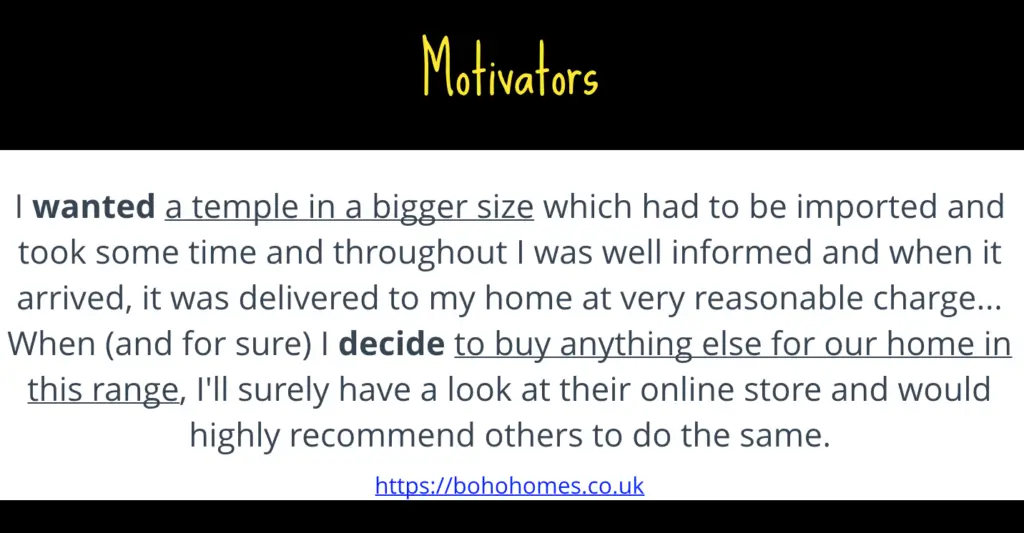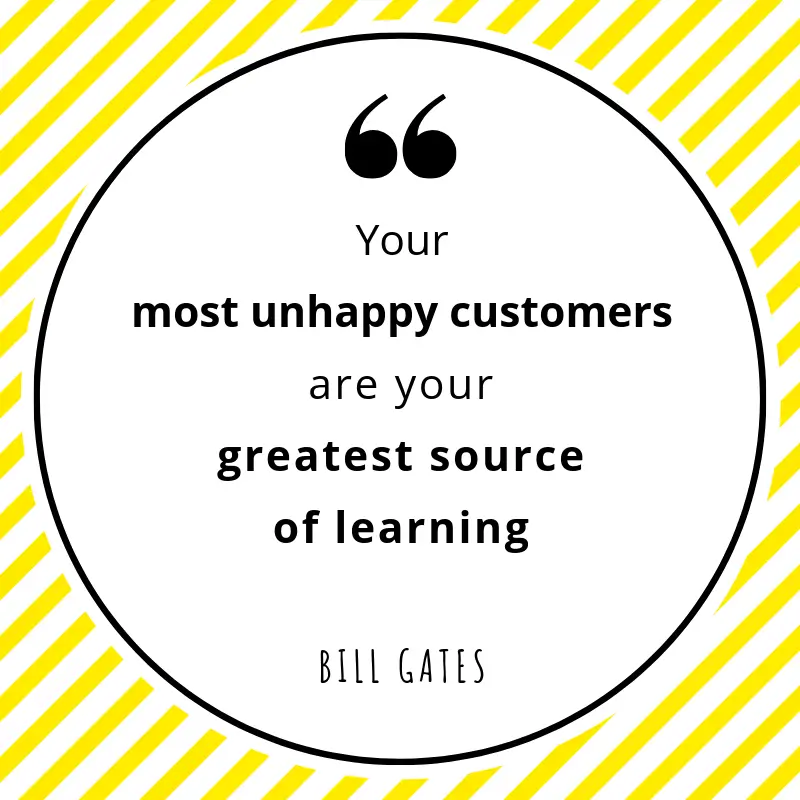
Knowing your customers is your single most important business superpower:
- It allows you to craft irresistible offers, because you know what’s irresistible to your customers.
- It allows you to attract the right audience in a targeted way, because you know what they will respond to.
- It allows you to give your brand a unique voice, because you know what will resonate with your kind of people.
Many brands already know this in theory.
And still, they aren’t able to harness the power of knowing their customers.
Instead, they’re satisfied with doing a bit of market research and running a few focus groups — essentially, collecting a bunch of opinions.
But to really understand your customers, you need to be able to read the values that are expressed in those opinions.
That’s what this article is all about.
Why online reviews are such a rich source of business insights
Customer reviews are treasure troves of insight:
- They’re free of charge.
- They’re publicly accessible and plentiful.
- They’re usually spontaneous, organic expressions of a customer’s concrete experience with a product or service — a true measure of what they think.
- Reviewers often use natural, conversational language.
- Even if you’re still developing your offer, you can already look at reviews for similar products and services to understand what people like and dislike.
- Nearly every industry is covered — from left-handed candles (5 reviews) to finger puppets that look like tiny hands (264 reviews).
There’s only one downside — and it’s important to bear in mind.
According to a 2006 study by A. Ghose, Reviews tend to represent the more extreme poles of the customer happiness spectrum (“Designing Ranking Systems for Consumer Reviews: The Impact of Review Subjectivity on Product Sales and Review Quality” – find it on ResearchGate).
People who feel indifferent about something are usually less inclined to leave a review, so you’ll end up with lots of enthusiasm on the one hand and a lot of scathing criticism on the other.
Where to find relevant customer reviews
Depending on your industry, you’ll want to look at one of the following 7 sources:
- Supermarkets and department stores online
- Dedicated review sites
- Reseller sites for your industry (such as booking.com for hotels, or Amazon for almost any physical product)
- Social media sites like Reddit
- Search engines
- Hauls & experience Vlogs on YouTube or TikTok
- Directly on your competitors’ websites
How to analyse customer reviews
(1) List the aspects people comment on
Are you a techie or AI user?
You could crawl customer reviews automatically to find the features that people talk about. That’s what Minqing Hu and Bing Liu did in their study about Mining and Summarizing Customer Reviews.
Not your thing? Not to worry: you can always go through the reviews manually.
To get some valuable insights into your market and your ideal customers’ likes and dislikes, you need not even read all available reviews (some products have tens of thousands of them).
Just remember to use additional sources of information for context.
For example, you could interview 5-10 customers or read customer care conversations.
(2) Make a table, listing positive and negative comments on each feature in separate columns
This is another one of Hu and Liu’s methods.
It’s a clever way to keep things tidy.
The important thing is to record comments as they appear, so you capture the customer verbatim with all its emotional expressiveness. The easiest way to do that is by copy/pasting their comments into a spreadsheet, like so:

(3) Pay attention to these words and expressions in online reviews
Once you’ve got a nice collection of comments, it’s time to dig into the details.
Read for descriptive words
Look for the adjectives and adverbs: words such as cute or fast or impressive.
For example, let’s have a look at this review for Where Does It Come From?

This customer is really happy about the jeans they bought for their son. If we highlight the descriptive words, we’ll see at a glance what matters to this customer:
- Thrilled (→ refers to customer experience)
- Impressed (→customer experience)
- Lovely (→ customer experience)
- Special (→ customer experience)
- Soft (→ refers to product)
- Adjustable [waist] (→ product)
- Growing (→ product)
- Helpful (→ customer experience)
Pay attention to how people describe the products they’ve bought from you and their experience. Their descriptions will show you what they really value, and what’s worth highlighting in your marketing.
You can even use their exact words to make sure your message resonates.
Work through SMOG language and motivators
I first came across this advice in former hostage negotiator Richard Mullender’s eye-opening book, Dispelling the Myths and Rediscovering the Lost Art of Listening.
- SMOG is an abbreviation for should, must, ought to, got to.
- Motivators are words that express the motivation for a certain course of action or a way of thinking — for example: I wish, I would like to, I’m determined to.
Whenever you see one of these words, Mullender recommends paying extra attention to the action following it — because it’s particularly important to that person.
Let’s consider the following example, taken from Boho Homes London.
This is a company that sells beautiful artisanal homewares, made by social enterprises and Fairtrade suppliers in Asia.
One of their customers bought this temple for their home:

Here’s their review.
I’ve highlighted the motivators in bold text and underlined the important points that follow them:

Apparently, this temple is quite a bit bigger than the one on the website, and it was especially imported for this customer. Therefore, it seems that the size of the temple really mattered to them.
It’s interesting, too, that this customer talks about future purchases as a decision — emphasising the rational aspect of the purchase.
The fact that the “range” is mentioned points to a desire to match their home decor.
Look out for emphasizers
Words like very, really, truly, incredibly add extra oomph to the words that follow them.
Any comments that contain an emphasizer deserve your special attention.
Sustainable tailors, Gillian June, make bespoke ethical women’s wear.
Here’s a review from a happy customer:

Once again, I’ve put the emphasizers in bold and underlined what follows.
This immediately draws our attention to the most important aspects of the jacket in the eyes of this customer:
- Uniqueness
- Ethical production
- Handcrafted items
- The personal touch
- Knowing the story behind the different materials
- Personality
- Romance
- Magic
It’s always interesting to check which of these aspects come up a few times in different people’s reviews. Those are the ones you want to focus on in your marketing. They can also guide your product development in a customer-friendly and therefore sustainable way.
Do not overlook explicit statements
Let’s go back to Richard Mullender’s advice.
According to his experience, a person who says someone’s “loud and aggressive” is really telling you that they do not like loud and aggressive people. Equally, a person describing someone else as “friendly” reveals that they like to be treated as a friend. They like people to be nice.
While this may sound blatantly obvious, it’s all too easy to skim over a customer review and overlook the rich detail it contains.
Each word matters — allow yourself to really dig into each review and savour each expression for what it reveals about your customers’ preferences.
The art of hearing the unsaid
Hearing the unsaid is an art and a skill at the same time.
One helpful technique is simply to ask, “what do people not talk about in these reviews?”
For example, let’s assume you’re looking at reviews of an online health tracker.
- Are they talking about where those trackers were made?
- Are they talking about the price?
- Are they talking about privacy?
- Are they talking about the feel of the tracker while wearing it?
Think about your product and all the things that people could, in theory, comment on. What are people actually talking about — and what rarely comes up?
If people are not commenting on the price, then it does not seem to be all that important. That’s good to know because it helps you set your prices with more confidence.
Another useful technique comes from root cause analysis: take a single statement in a review, and ask “why” seven times.
Let’s apply this technique to the adjustable kids’ jeans in our previous example:

- Why does this customer love the adjustable waist?
— Because she has a boy who’s still growing. - Why is it important to dress her growing boy in jeans with an adjustable waist?
— Because she won’t have to buy as many jeans. - Why won’t she have to buy as many jeans?
— Because she can go for a bigger size and let her boy “grow into” the jeans while she keeps adjusting the waist. - Why would she want to go for a bigger size?
— Because it’s more comfortable than jeans that are even slightly too small. - Why are jeans that are a bit on the small side uncomfortable?
— Because kids like to run and play. - Why should kids wear adjustable jeans when they run and play?
— Because they can move freely, the denim protects them when they fall or scrape their knees, and they keep warm even on cooler days. - Why is it important to parents that their kids can move freely, and that they’re protected and warm?
— Because they love them.
Asking seven times Why? means that we have to make an effort to empathise with the customer.
As a reward, we arrive at a much deeper understanding of what’s going on in that person’s head.
When you ask seven times Why?, some of your answers will be conjecture.
To validate your ideas, you can interview customers (in this case, parents buying jeans for their kids).
Turning insights from online customer reviews into values-based marketing
Now you’re ready to use your discoveries strategically in your own marketing.
You’ll probably have ended up with reams and reams of insights, and you’ll want to prioritise them in your marketing. Do not explore too many directions all at once — instead, it pays off to stay laser focused on the right messages.
To find that all-important focus, I recommend you prioritise according to the 3 Rs: Really, Reach, Resonate.
Really:
What was emphasised in the reviews? (Look out for words like really, truly, utterly, etc. They show you what people respond to emotionally.)
Reach:
This has a double meaning:
- What’s been mentioned most frequently?
- Which aspects have the biggest reach, in terms of setting your business apart? The most far-reaching values probably deserve the most attention from you.
Resonate:
Which insights resonate most with you? After all, it’s important that you feel that people love (or reject!) your offer for the right reasons.
And finally, I want to leave you with one of my favourite quotes:

So, if you see a lot of complaints about something, consider prioritising that aspect in your marketing, if you can. Especially if those negative comments refer to competitors’ products.
As a straightforward example, think about the fight to reduce single-use plastic packaging.
People are complaining about plastic packaging — fortunately!
If your products are plastic-free, or packaged in recycled or reusable plastic, then that’s an easy win for you.
Or, to give you another example — I’ve noticed lots of companies complaining about “flaky”, unorganised copywriters who do not stick to deadlines. That’s why we emphasise our project management skills and reliability in our marketing.
That’s what value-based marketing is all about: taking people’s opinions, digging deeper and ask why they hold the opinions they share. Why does it really matter to them? How can you help them improve their lives with your products?
As you write your website copy, product descriptions and newsletters, make sure you use the customers’ own words as much as possible.
If that’s not an option for some reason, look at the unspoken values you uncovered through asking “Why?” and speak about them.
Using this approach, you can go beyond the traditional, superficial advertising of your product – and optimise for conversion without the cringe factor.
We’re here to help
Optimising product and pricing pages for conversion is one of our favourite kinds of project. Get in touch today to check if we’re a good fit.